I've previously mentioned that during the 1950s the Iowas were fitted with a 16" nuclear shell, the Mk 23 "Katie".1 This is a fascinating device, one of a plethora of nuclear weapons that were developed in the mid-50s. But how did the Katie come about, and what modifications were made to the battleships to allow them to use it?
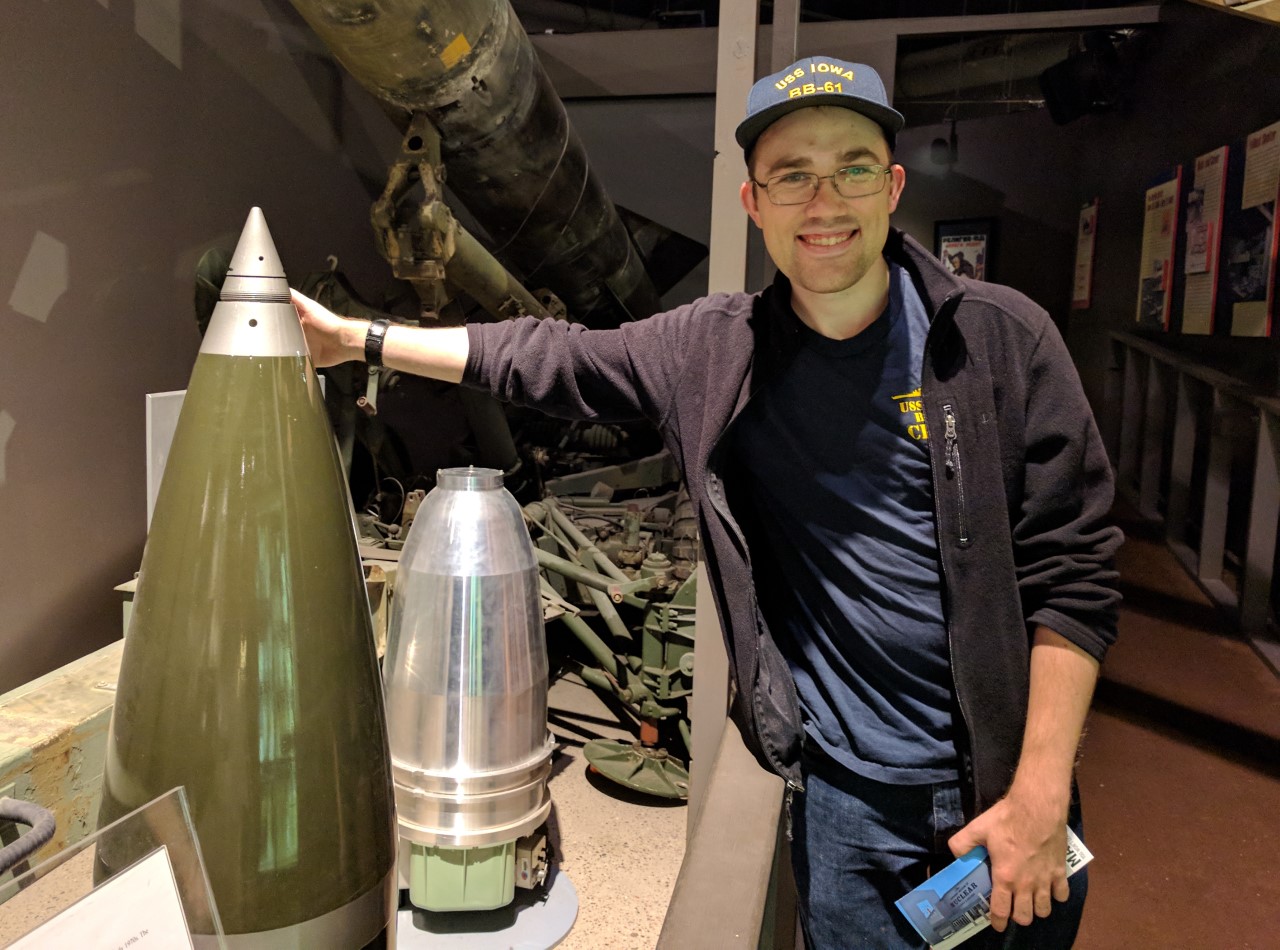
Me with the Mk 23 at the National Atomic Museum2
The Katie has its origins in the Mk 9, the world's first artillery-fired atomic projectile (AFAP). The Mk 9 was the Army's first nuclear weapon, part of its bid to keep itself relevant in an era when atomic weapons were expected to dominate the battlefield of the future.3 The designers faced serious challenges. An artillery shell is an incredibly difficult environment to put a complicated device like a nuclear warhead. It must withstand normal handling, thousands of Gs of acceleration as it's fired, and the centrifuge of a shell spinning at 10,000 rpm or more. It must be incredibly reliable, as a nuclear shell that doesn't go off is not only a waste of money but might give the target valuable materials or insight. And it needs to be compact, as big artillery pieces are heavy, expensive, and difficult to move. Ideally, a nuclear shell would be for an existing weapon, probably the 240 mm M1 howitzer, the biggest gun in the Army's inventory.
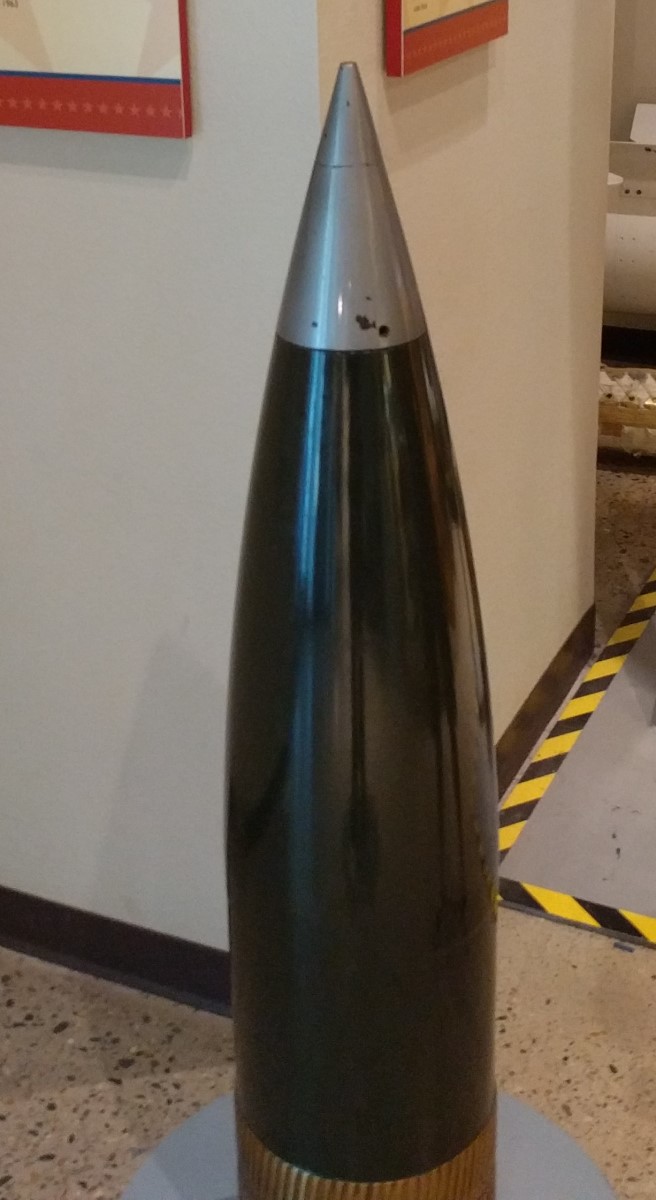
280mm nuclear shell at the National Atomic Museum
Unfortunately, when development began in 1949, the state of the art in nuclear weapons technology wasn't really up to solving all of these problems very well. Most nuclear weapons use an implosion system, where carefully-shaped explosives compress a core of fissile material until it's dense enough to support a chain reaction. It's efficient and powerful. However, the smallest implosion bomb of the time, the Mk 7, was 30" in diameter. This would require a gun of impractical size for any sort of tactical use. So the designers turned to gun-type devices. These assembled their fissile material by firing one section into another using what was essentially a gun. Little Boy, the bomb dropped on Hiroshima, was of this type. It was much less efficient than an implosion device,4 and required 145 lb of uranium instead of plutonium, but it was inherently more durable and could be made smaller. The final yield was around 15 kt, the same as Little Boy, and slightly lower than the implosion-type weapon dropped on Nagasaki.
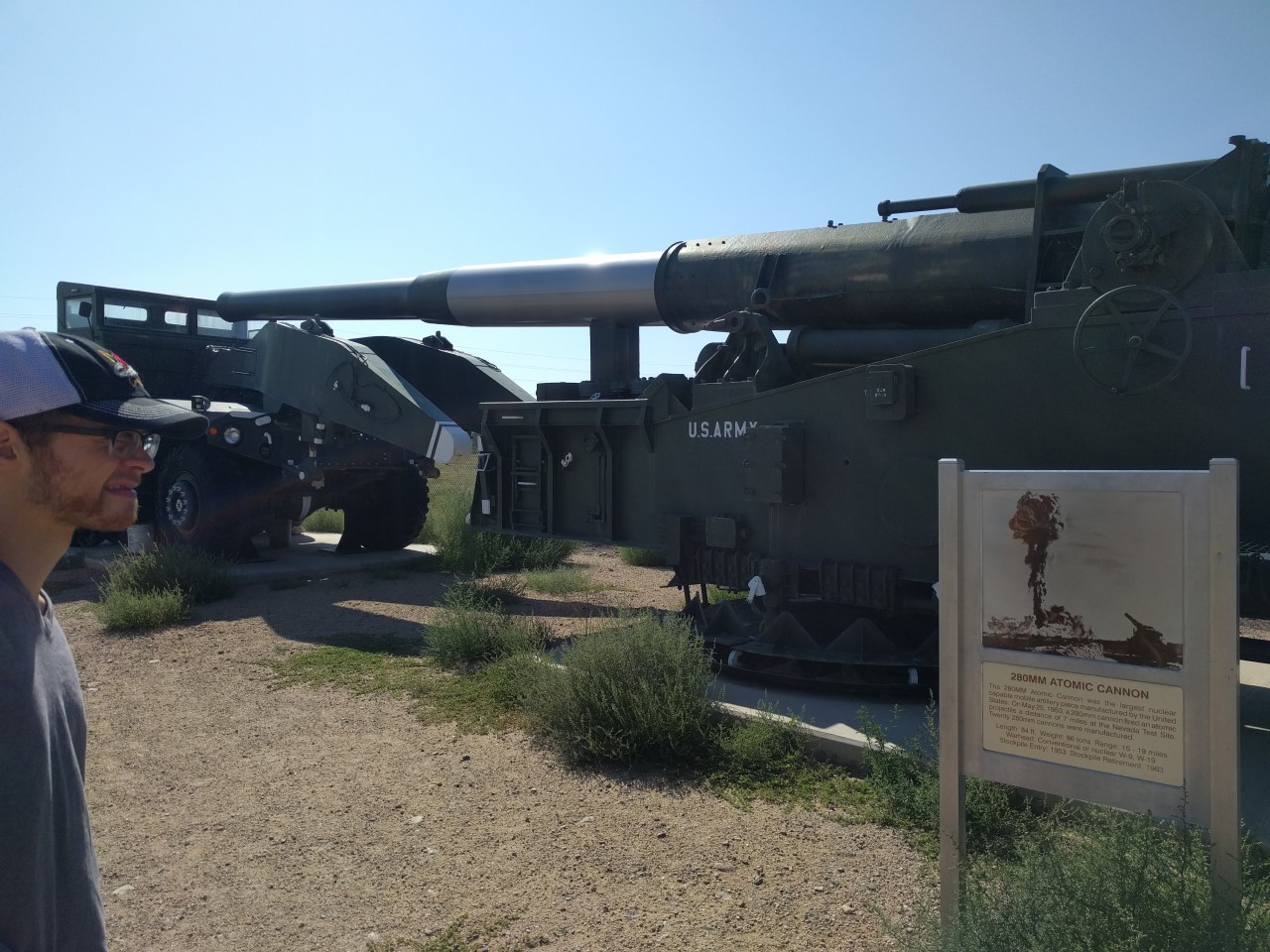
280mm Atomic Cannon at the National Atomic Museum
Even using a gun-type device, the designers were unable to squeeze it into a 240 mm shell, and a specialized weapon, the M65 280mm "Atomic Cannon", was developed to fire the nuclear shell. The M65 was a high-profile weapon, with the prototype taking part in Eisenhower's inaugural parade. However, while it was impressively mobile for such a large weapon, taking only 15 minutes to switch between moving and firing, it was large, expensive, and had an annoyingly short range of only 26,300 yards. Only 20 were ever built, and they lasted a mere decade in service before missiles and nuclear shells for smaller artillery pieces rendered them obsolete.
However, for a few years the M65 was one of the most important pieces of equipment in the Army inventory, and they set about trying to fix at least one of its flaws, namely the rather short range. The easiest way to do this was to make the shell lighter, and an improved version of the Mk 9, the Mk 19, was promptly designed. The Mk 19 shells weighed only 600 lb, as opposed to the 850 lb of the Mk 9, at the cost of using even more precious uranium. This increased range to 32,700 yards.
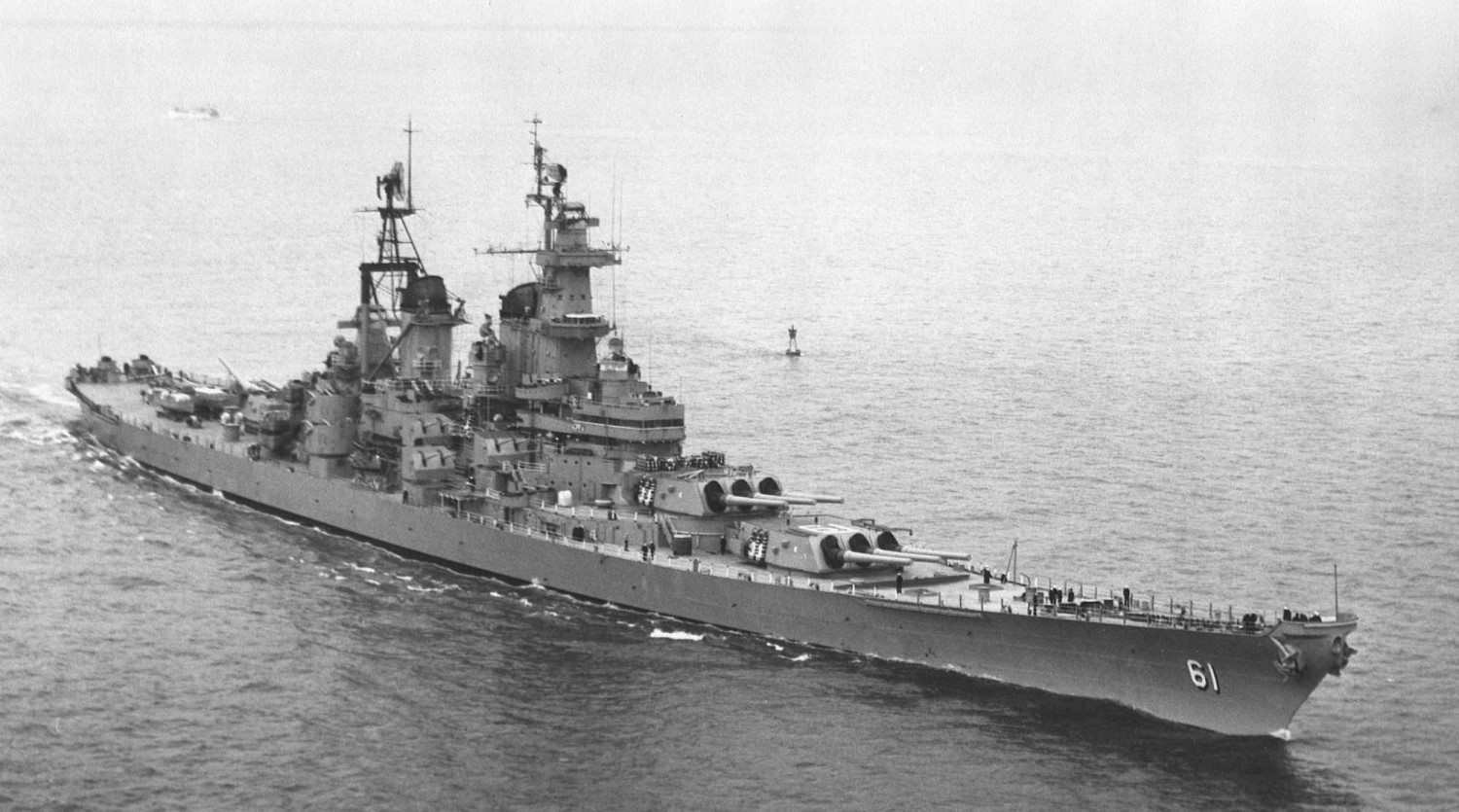
Iowa in the late 50s
Into this came the Navy and, more importantly, the Marine Corps. The Navy already had atomic bombs for land attack and hunting submarines, but the Marines were nervous about the Navy's ability (and/or willingness) to provide nuclear fire support during an amphibious invasion. A nuclear 16" shell would calm these worries nicely.5 It would be relatively easy to build, drawing on the existing knowledge of nuclear artillery shells, and provide shore bombardment capability without relying on airplanes and bombs that might be diverted elsewhere. The project officially began in late 1953, and the Army offered to simply adapt the internals of their shells to fit a 16" gun. When it entered the stockpile in October of 1956, the Mk 23 used the same nuclear components as the Mk 19, and had the same yield.6 The resulting shell was ballistically identical to the standard 1,900 lb HC shells, allowing them to use the same cams in the fire control computer.
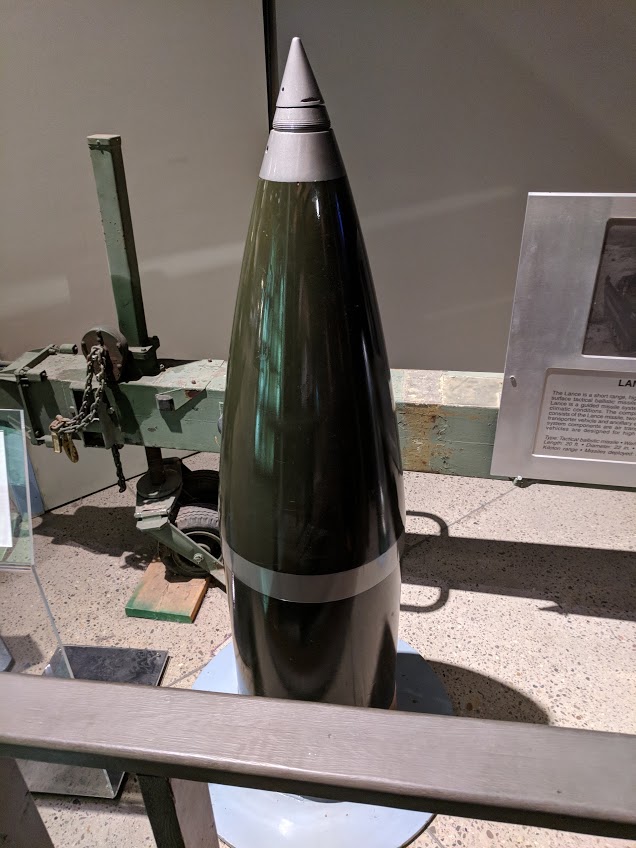
A Mk 23 at the National Atomic Museum7
Ultimately, 50 Mk 23s were manufactured, and Iowa, New Jersey and Wisconsin8 were modified to carry ten nuclear and nine Mk 24 practice projectiles in the magazine of Turret II, as well as a single drill projectile.9 If one of the other turrets was to fire the Mk 23s, they would have been transferred via the rail system installed on Broadway. Unfortunately, the exact nature of these modifications has never been published, but at the time, nuclear components were almost always stored separately from the rest of the weapon. It's likely that there was a secure locker for the uranium, and an area where specially-trained crew members could assemble the projectiles. The locker would probably have been guarded 24/7 by the ship's Marine detachment, as were the Tomahawks in the 80s.
The US Navy refuses to confirm or deny the deployment of nuclear weapons at sea, with the exception of the ballistic missile submarine force. However, Sumrall indicates that the full compliment of nuclear shells did go to sea aboard Iowa and Wisconsin, and that the later ship did fire a number of the practice projectiles. New Jersey apparently only carried a single drill projectile.10 Only 18 months after the Mk 23 was introduced into service, the last battleship was retired. Despite this, the nuclear shells remained in the US stockpile until 1962. One projectile was apparently modified for a peaceful nuclear test under Project Plowshare in 1961, although I'm not sure if it was ever used.11

Grable Shot, Operation Upshot-Knothole
The only live test of any of these shells was when a Mk 9 was fired from one of the 280 mm cannons during the Grable shot of Operation Upshot-Knothole at the Nevada Test Site in 1953.12 This was only the second gun-type device ever set off, and the only live firing of an atomic artillery shell. The test was a complete success, and the weapon had the same yield as Little Boy had had eight years earlier, despite an elevenfold reduction in weight and a fourteenfold reduction in volume.
Later nuclear artillery shells fit into 8" and 155 mm shells, and most used more efficient implosion designs. There was even some speculation that nuclear shells would be developed for the Iowas when they were reactivated, although I've never seen any suggestion that this was seriously pursued. The 280mm projectiles almost had a second encounter with the battleships, too. During New Jersey's deployment to Vietnam, the Navy looked into using some of the leftover 11" shells,13 fitted with sabots, to extend her range inland.14 This never came to fruition, nor did similar suggestions for reuse during the 80s.
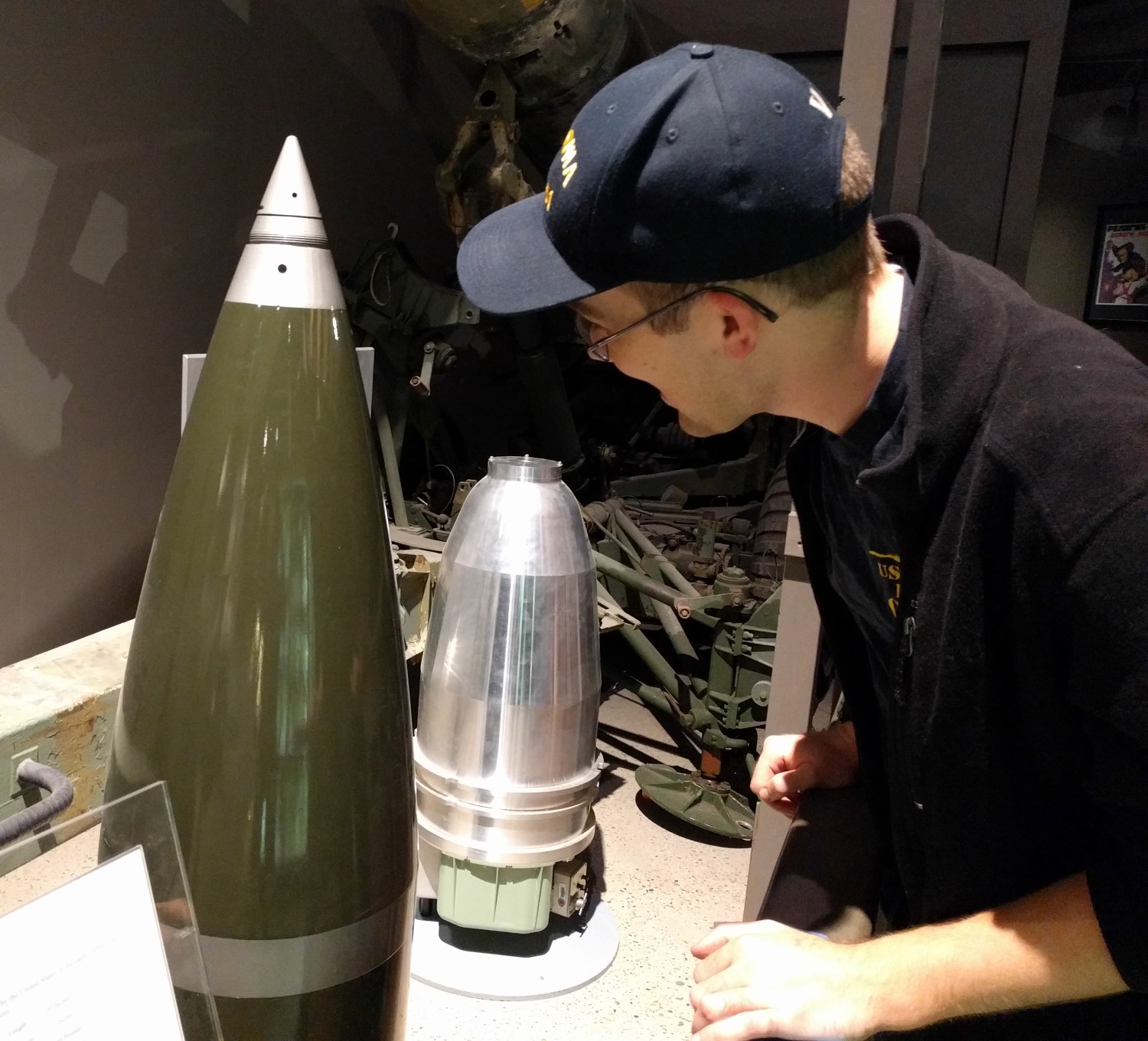
Me examining the Mk 23
The Mk 23 is a fascinating artifact of the early Cold War. While it was only in service for a few years and never came anywhere close to use, it retains the distinction of being the only nuclear projectile ever created for a naval gun. And the mere fact of its existence offers an interesting window into the mindset of US thinkers during the height of the nuclear arms race against the Soviets.
1 It's usually reported that this is from the abbreviation for kiloton, kT. I don't believe this to be the case, as Swords of Armageddon, my main source for this post, says that this was the codename for the project from the start. ⇑
2 My photo, as are all pictures not otherwise credited or obviously not mine. I'm not actually touching it, and I even managed to not drool on it too much. ⇑
3 I should probably point out that the perception of nuclear weapons in the late 40s and early 50s was very different from that of today. At the time, nuclear weapons were seen as very powerful explosives, and the idea of using them to support troops was completely natural. For very complicated reasons, this changed radically in the late 50s and early 60s, and today, nuclear weapons of any kind are indelibly associated with Armageddon. ⇑
4 This was a major concern at the time, as the US was building as many nuclear weapons as it could, and fissile material is expensive to produce. ⇑
5 Weirdly, it wasn't the first 16" nuclear shell mooted by the US. The Coast Artillery Corps had asked for a 16" nuclear shell for its guns just before it was shut down in 1950. ⇑
6 I find this slightly strange. The Mk 19 was considerably more expensive than the Mk 9, and the only real improvement was a 250 lb weight reduction. This is obviously meaningless when you have a 1,900 lb shell to play with. It's possible that this was for logistical reasons, allowing the Mk 9 nuclear components to be retired. ⇑
7 Thanks to Andrew Hunter for the photo. ⇑
8 Missouri was already scheduled for deactivation when the program began and she was laid up before the Mk 23 entered service. ⇑
9 The carriage of practice projectiles is interesting. In theory the ballistics should have been the same as normal 1,900 lb shells, so I'm not sure why dedicated practice shells were needed. The only theory I have is that the Mk 9 projectiles at least had a time fuze, not a proximity fuze, presumably to avoid enemy countermeasures, and it would have taken practice to get that right. (Nuclear weapons are significantly more forgiving than conventional ones of the sort of errors that proximity fuzes eliminate.) The Mk 9/Mk 19 required several registration rounds to be fired before the projectile, although this might have been rendered unnecessary thanks to the superb fire control system of the Iowas. ⇑
10 This is probably because of when the ships were retired. New Jersey was inactivated in August 1957, 8 months after the Mk 23 entered the stockpile. Iowa survived until the next February, while Wisconsin followed her into retirement in March. ⇑
11 I say "apparently" because this doesn't make much sense. The Mk 23 was very inefficient, and it would have presumably been better to recycle the highly enriched uranium. Swords of Armageddon indicates that the modified projectile was a Mk 23 Mod 1, which is the only indication we have that there may have been multiple versions of the Mk 23. It was probably a fairly minor mod to fusing or the non-nuclear components, but we still know relatively little about the Mk 23 even 60 years later. ⇑
12 Interestingly, this weapon is now on display at the superb US Army Artillery Museum at Fort Sill, OK. ⇑
13 There was also a high-explosive shell built for the M65, and the proposal referred to those, not nuclear shells. ⇑
14 I don't have good numbers on this, sadly. A related project took two 16"/45 barrels, welded them end-to-end, and managed to fire a saboted 280mm projectile 83,850 yards, but I don't know what a normal 16"/50 would have done. ⇑

Comments
I should hope you didn't get too much drool all over Katie.
And I should hope we all understand that the only real purpose of nuclear artillery shells is to be awesomely cool. Rockets and missiles beat guns and shells in every way except size and bulk of the munition, but the trade almost never favors guns unless you're going to be firing 50+ rounds per mount.
For nuclear naval fire support, it would have been far more cost-effective (and combat-effecive) to put navalized Honest Johns in an armored box launcher on the amphibious assault ships. Or to use the nuclear-armed Terrier and Talos missiles that started showing up on the CGs and DDGs about that time. Longer range, better accuracy, less use of scarce fissile material, no need to develop a new and highly specialized weapon. Just not as cool as a ginormous cannon firing nuclear shells.
But, OK, ginormous nuclear cannon are cool. Battleships are cool. Consider the missed opportunity. The Mark 19 was an 11" nuclear shell. The USN never fielded an 11" gun, but the United States did share nuclear weapons with some of its NATO allies. Including Turkey.
The Yavuz was retired in 1950. So we missed by six years, the chance to face down communist tyranny with a genuine Second Reich Battlecruiser armed with ginormous nuclear cannons. Hopelessly impractical, but then so was Katie. Politically dubious as well. But if you're going for cool, that would have been maximized coolness. Well, maximized short of the schemes that involve raising the Yamato and refitting her with some sort of mythic superweapon...
Is that lightning in the background of the Operation Upshot-Knothole image?
@LordNelson
It's smoke. Before a test shot, they would use rockets to lay calibration lines with smoke so that images of the test's progress could be scaled correctly.
@John
The image of Yavuz with those shells is absolutely glorious. I should point out, though, that it was only 3 years or so off. The 11" Mk 9 entered service sometime in 1953, not 1956. And you're absolutely right about other nuclear weapons. In fact, I believe that there was discussion of using the 3T missiles as bombardment weapons, probably in Friedman's destroyers.
@LordNelson
DirectrixGazer has part of it. The other part is that they made it possible to see the shockwave as it went through them.
What's the difference between a "drill" and a "practice" shell?
A drill shell is intended for turret crew practice. It's the right weight and about the right shape, but ours, at least, were flat-nosed. Basically, it's a chunk of steel designed to let the gunnery people practice loading the guns, but it won't fly right if you fire it, which you shouldn't. A practice shell, on the other hand, is the right shape and weight, and is intended to be fired out of the gun for target practice. Sometimes, there's a small charge installed to make spotting easier. I believe all of the shells aboard Iowa today are practice ones for obvious reasons.
@John Schilling
It sounds like the plot to a Stephen Coonts book - WWI battlecruiser, destined for the scrapyard is secretly reactivated to carry a nuclear payload on a secret mission with world-spanning implications.
All I'm sayin' is, would Vladimir Putin have dared seize Crimea if the pride of the Kaiser's fleet had been cruising offshore with a full load of nuclear ordnance looking for a rematch? I think not!
Maybe just because he was laughing too hard, but I would prefer to say he was dumbstruck by the sheer awesomeness...
You know, this is proving a lot more plausible than I'd like. Google was completely unhelpful in finding where Yavuz was scrapped and who was responsible. Every single hit for "M.K.E. Seyman" appeared to be a reference to her scrapping, and not one gave a location. Further investigation in a book showed that it was probably supposed to be M.K.E, Seyman. But that raises the second problem that Seyman has no wiki article and doesn't show up on Google Maps.
Ship scrapped in a location I suspect to be fictional? Yeah, this is definitely starting to sound like a thriller.
The mystery deepens. I have an entire book with a chapter on Goeben/Yavuz, and it didn't say where the ship was broken up, either. I'm now really suspicious, and considering trying my hand at fiction.
Well I finished reading "A Blunted Sickle" a couple weeks back, so I for one would like some more good military fiction.
So, when the Goeben/Yavuz eventually does go back to sea, she'll presumably need a screening group. I assume that will consist of HNLMS De Ruyter, Java, and Kortenaer?
You know, I'd idly considered that their disappearence might be somehow related. But that's definitely the best way to incorporate them.